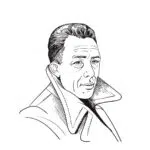Marie Curie, born November 7, 1867, died on July 4, 1934, at 67. She was a Polish scientist and chemist who carried out ground-breaking radiation research. Curie is the first person to have won the Nobel Prize in two distinct scientific domains, the first woman to do it, and the first person to do so twice. She and her husband, Pierre Curie, shared the first Nobel Prize, thus making them the first married couple to win the esteemed award. Between them, the Curie family has five Nobel Prizes to their family’s name.
Fast Facts
Full Name:
Maria Salomea Skłodowska–Curie
Birth date:
November 7, 1867
Death date:
July 4, 1934 (age 66)
Zodiac Sign:
Scorpio
Height:
5' 0"
Net Worth:
$1.5 million
Background
Curie was born in Warsaw, Poland, as the youngest of five siblings, on November 7, 1867. Her parents were well-known teachers. She followed in her father’s footsteps, who taught mathematics and physics, subjects that Curie later pursued. Curie received her education in local schools and some scientific training from her father. She and her sister were not permitted to enroll in a regular university because they were women, so they got involved with an underground educational enterprise known as “Flying University.”
In 1891, Curie left for Paris, where she joined the University of Paris and continued to study physics, chemistry, and mathematics. She obtained two degrees in Physics and Mathematical Sciences. She met her husband, Pierre Curie, in 1894 and married him a year later. The two worked together, sharing their passion for science and physics. After Henri Becquerel discovered radioactivity in 1896, Curie developed methods to separate radium from the radioactive residues, thus, enabling her to study its properties. In 1903, she and Pierre received the Nobel Peace Prize for their work.
Pierre died in 1906, and Curie took his place as Professor of General Physics in the Faculty of Sciences. Like many other achievements in her life, she was the first woman to hold this position. Curie died from aplastic anemia in 1934, at age 66, which was likely caused by radiation exposure. She left behind a scientific legacy and a significant mark on the scientific world.
Career timeline
Russia forbids any woman from attending university, forcing Curie to relocate to Paris and enroll in the University of Paris.
Curie is awarded her degree in physics and begins working in the industrial laboratory of Gabriel Lippmann.
She and her husband discover polonium, a new element 400 times more radioactive than uranium.
Curie gains her Doctor of Science degree.
Curie is awarded another Nobel Prize for the isolation of radium.
Why We Love Marie Curie
She was a trailblazer
Curie's research changed history, making her work indispensable to modern medicine and science. She established the Curie Institute in Paris in 1920 and the Curie Institute in Warsaw in 1932. Both institutions are still important hubs for medical research today.
She was a female role model
Curie helped pave the path for women scientists in a subject previously dominated by men in math and science. Not only was she the first woman to receive the Nobel Prize, but she was also the first and only one to do it twice. Curie is the first woman to have a professorship at the University of Paris and the only woman to have received the Nobel Prize in two distinct scientific categories.
She persevered through tough times
There were many setbacks in Curie's life, but she continued to follow her passion and succeed in her chosen work. Despite having no money in her earlier years to go to University and higher education not being available for girls in Poland, she fought all the odds. Even after her death, she is still remembered for her contribution to the world of science and physics.
5 Surprising Facts
She funded her sister's education
Curie took up a governess position to fund her and her sisters' schooling.
She won a scholarship
Curie finished at the top of her class at the University and was awarded the Alexandrovitch Scholarship for Polish students studying abroad.
She came up with the word 'radioactive'
Curie first used the word 'radioactive' in a paper while studying X-Rays which she was fascinated with.
She discovered 'polonium'
In 1898, Pierre and Curie discovered a previously undiscovered radioactive element and named it 'polonium,' after Poland.
Buried in the Pantheon in Paris
Curie and her husband are buried in the Panthéon in Paris alongside France's greatest citizens.
Marie Curie FAQs
What is Marie Curie most famous for?
Curie is the scientist who discovered radium and polonium and her huge contributions to finding cancer treatments.
Are Marie Curie's notebooks radioactive?
Yes, some of Curie’s notebooks are still radioactive.
Did Marie Curie give away her Nobel Prizes?
The French National Bank rejected Curie’s offer to give her gold Nobel Prizes for the war effort.
Marie Curie’s birthday dates
| Year | Date | Day |
|---|---|---|
| 2025 | November 7 | Friday |
| 2026 | November 7 | Saturday |
| 2027 | November 7 | Sunday |
| 2028 | November 7 | Tuesday |
| 2029 | November 7 | Wednesday |




















